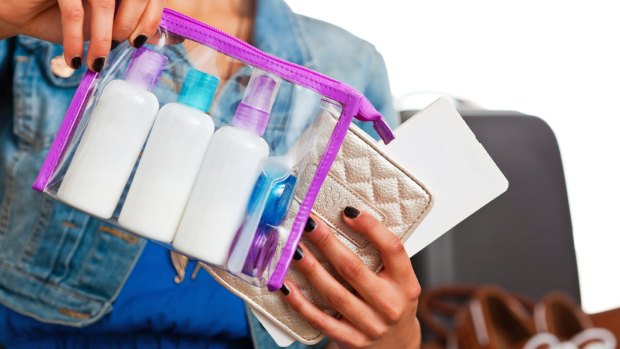This was published 7 years ago
New airport scanners may mean liquids and laptops can stay in your luggage

You may soon be able to leave your liquids in your carry-on bag.Credit: iStock
Air passengers could soon be spared the chore of having to remove their laptops and liquids from their carry-on luggage when going through security.
New equipment, using what is known as CT technology, is being tested in Britain and the United States and could slash the times travellers spend getting through to the departure lounge.
Working in much the same way as CAT scanners do in hospitals, the new devices take detailed images of what is inside a passenger's luggage.
A number of airports are already using the technology to screen hold luggage and now the industry is trying to develop portable scanners for use on hand baggage at security checkpoints.
A complete ban on carrying liquids onto an aircraft was introduced in August 2006 after a terrorist plot to down a transatlantic aircraft, by mixing the liquid components of a bomb on board, was thwarted.
Although it was later eased to allow passengers to bring liquids in containers up to 100ml, the restrictions cause inconvenience to passengers who have to put fluids into small plastic bags (which some airports charge £1 for) and take them out of their hand luggage for inspection.
Lengthy security delays have frustrated passengers, and many have missed flights due to the time taken to clear the checkpoints.
The aviation industry has long regarded airport security as one of the pinch points in the system and the aggregation of a large number of passengers in one place can also leave them more vulnerable in the event of a terrorist attack.
Speeding them through airport security is seen as one of the industry's main priorities and a number of companies, such as Smiths Detection in Watford, are understood to be working on developing devices which can be used at passenger checkpoints.
"The UK has some of the strictest security measures in the world, and we are leading the way in using new technologies to improve security screening at airports, as well as improving the passenger experience," said Lord Ahmad of Wimbledon, a transport minister.
"We already have state of the art automated screening lanes in place at many of our airports, and new CT technology is also being trialled here. We will continue to work closely with our US counterparts to harness the latest advances in technology."
In the United States, the Transportation Security Administration (TSA) has announced a trial in co-operation with American Airlines, with the first pilot study taking place at Phoenix, Arizona.
If successful, the CT technology could be deployed across the country.
The TSA announced its initiative six weeks after Kelly Hoggan, its head of security operations, was removed from his post and put on administrative leave because of delays at US airports, which in some cases were over three hours long.
Aviation security experts gave a cautious welcome to the initiative.
"The machines have to be adaptable to new threats to the extent possible. Every time there is a new type of threat we can't be putting another box of technology into the footprint of a checkpoint," said Jeffrey Price, a professor of Aviation and Aerospace Science at Metropolitan State University in Denver.
The Telegraph, London
See also: The 20 most annoying things about travel
See also: How you can accidentally set off explosive detectors
Sign up for the Traveller newsletter
The latest travel news, tips and inspiration delivered to your inbox. Sign up now.